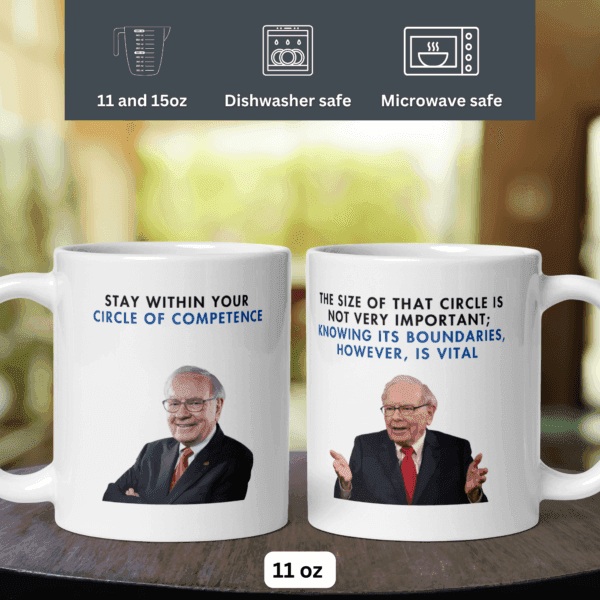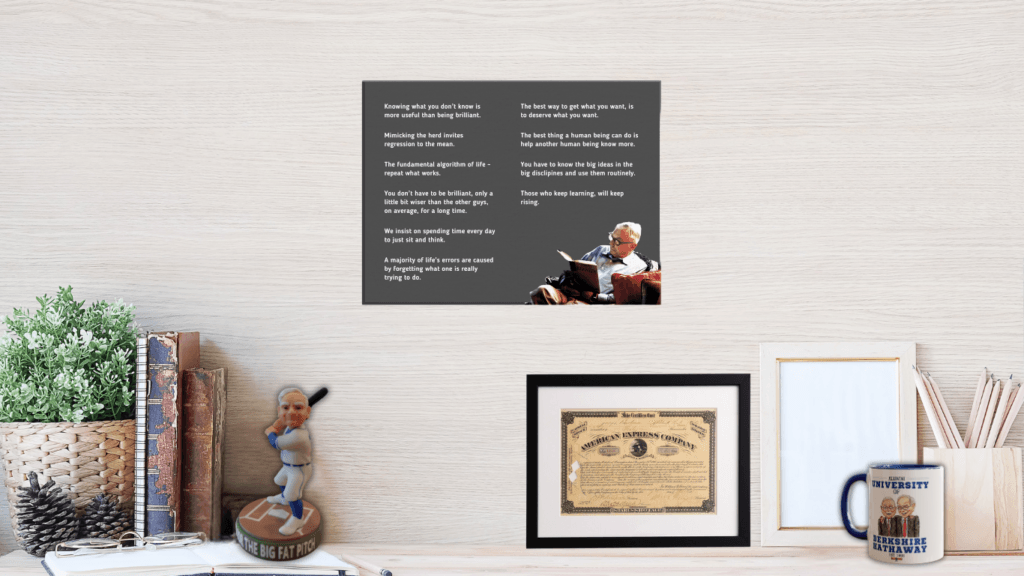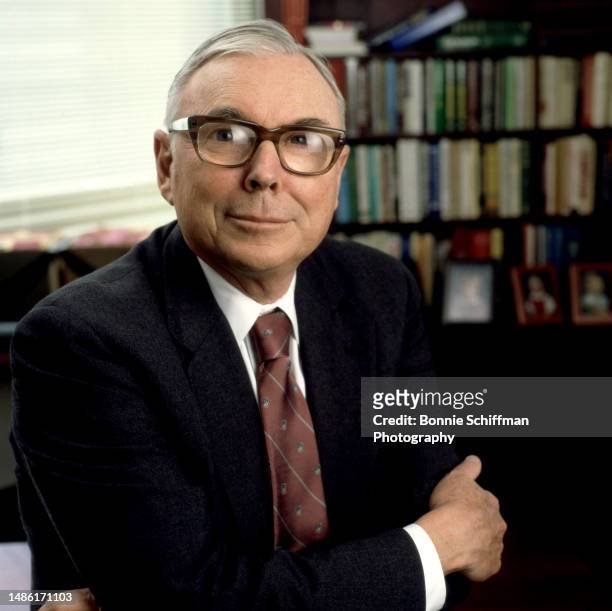Circle of Competence: How Warren Buffett Makes Better Investment Decisions
“I’m no genius, “I’m smart in spots – but I stay around those spots. ” – Thomas J. Watson Sr. of IBM
In the 2023 Berkshire Hathaway shareholder letter, Warren Buffett said that the satisfactory results of Berkshire Hathaway were due to ‘a dozen truly good decisions’. Although Buffett doesn’t spell these out, some of them are obvious. See’s Candy, Coca Cola, AMEX were pivotal bets that significantly moved the dial for Berkshire. Similarly, the insurance bets in GEICO, National Indemnity and the consumer giant Apple Inc. were hugely successful bets.
‘Circle of Competence’ was one of Buffett’s core investing principles and was a key ingredient in the above successes.
What is the Circle of Competence?
Simply put, circle of competence is the business, industry, sector, or domain where you have deep understanding. Buffett says that “The size of that circle is not very important; knowing its boundaries, however, is vital.” In the context of investing, its whether you understand a business deeply enough to ascertain its business model, its competitive positioning as well as predict its survival and growth.

Sometimes it can be unclear whether something is fully within your circle of competence or not. In such cases, how do you apply this circle of competence mental model? Charlie Munger used a helpful trick, “Asking that question is an answer in itself. If you are questioning whether something is in your circle of competence, it probably isn’t.”
In the below snippet from the 2022 Berkshire Hathaway Annual Meeting, Buffett and Munger discuss how investors can use the circle of competence mental model in investing.
When Buffett assesses a stock idea which isn’t in his circle of competence, he simply puts them away into the ‘too-hard’ pile and moves on. Buffett stuck to this approach during the 1990s technology stock boom, because he confessed that he didn’t understand the sector well. “I have no idea where Microsoft will be in 20 years from now, but I can say that people will still chew [Wrigley’s] gum.” Buffett said in a 1998 speech. Hence Buffett didn’t invest in Microsoft, although he admired Bill Gates and was close friends with him.
But Buffett didn’t just stick to his circle of competence, he expanded his circle of competence by being a continuous learning machine by reading everything he could get his hands, across a wide range of topics.
Although Buffett was disciplined to invest within his circle of competence, there were some ‘hits’ and some ‘misses’ and a Great Escape! Let’s explore some examples of each, through the lens of ‘circle of competence’.
Hits: Examples of Buffett’s Smart Bets
See’s Candy
This bet was wildly successful for Buffett, as his $25 million purchase of the See’s business in 1972 yielded billions of dollars of dividend over the next five decades. Before the See’s purchase, Buffett was mainly buying ‘cigar-butts’. I.e. stocks which looked extremely cheap based on quantitative factors. See’s was not a cigar-butt and Buffett had to pay double digit post-tax earnings multiple to purchase that business.
Buffett confessed that he fully understood the power of the See’s brand only when he saw that despite increasing the price of See’s chocolate every year, its revenues kept rising.
Coca-Cola
This was a home run investment for Berkshire. Buffett invested $1.3 billion in 1994 and has held it since. In 2022, Coca-Cola paid a dividend of $704 million.
Buffett understood Coca-Cola’s strong brand and global market potential. He recognized it as a business with predictable cash flows and a huge competitive advantage because Coca Cola commanded the ‘mind share’ of consumers in the soft drink market.
He rode the wave of Coca Cola’s global expansion in the 1990s which cemented Coke as a globally dominant brand.
In a 1998 lecture, he said that if someone was offered $10 billion dollars to disrupt Coca Cola’s dominant position in the soft drink market, it would be an impossible task to accomplish due to Coca-Cola’s brand power and ‘mind-share’. This is probably as true today as it was back then.
Buffett’s first hand experience with the See’s Candy business made him realise how powerful a brand like Coca Cola can be. This is a good example of Buffett expanding his ‘circle of competence’.
Geico
Buffett saw Geico’s direct-to-consumer model and low-cost structure as key advantages. He understood the power of the insurance float, which allowed Berkshire to invest cash received upfront from insurance customers into the securities market.
Having said that, the insurance operations truly flourished only after Buffett hired Ajit Jain to run the insurance business. Jain is especially known for his expertise in the reinsurance business and taking on large, complex risks that other insurers avoid and pricing these risks appropriately. Exemplary risk assessment and pricing were the pillars of Berkshire’s insurance success.
Banking Bets
Buffett has a great record of investing in the banking sector, he made huge returns on his investments such as American Express, Illinois National Bank and Trust Company, Bank of America, Wells Fargo, etc. Marc Rubenstien, a Financial Analyst and writer, has written an excellent, detailed piece on Buffett’s banking bets.
Apple
Buffett saw this bet as a consumer products business than a technology business. He saw how an IPhone customer was deeply entrenched into the Apple ecosystem. This customer stickiness made the Apple brand powerful.
Circle of Competence Coffee Mug with Warren Buffett Quotes
Misses: Lessons from Buffett’s Mistakes
Dexter Shoe Company
In 1993, Buffett purchased the shoe company for $433 million in Berkshire stock. Buffett admitted that he overestimated Dexter’s competitive advantage and didn’t fully recognise the threat of low-cost foreign imports. Dexter eventually went out of business making this investment a total loss. Buffett said that this was a “gruesome mistake” as he did not fully understand the industry’s dynamics.
In his 2007 letter, Buffett said “What I had assessed as durable competitive advantage vanished within a few years. By using Berkshire stock, I compounded this error hugely. That move made the cost to Berkshire shareholders not $400 million, but rather $3.5 billion. In essence, I gave away 1.6% of a wonderful business – one now valued at $220 billion – to buy a worthless business.”
IBM
Berkshire invested $13 billion in IBM in 2011, marking a shift from his long-standing avoidance of technology companies. He saw IBM not as a traditional technology company but as a business services company with strong customer loyalty and a strategic shift toward software and services, especially in cloud-computing. He saw IBM’s entrenched position with large corporate clients as a sustainable competitive advantage.
However, IBM couldn’t compete with more nimble tech companies like Amazon (AWS), Google, and Microsoft, which were rapidly gaining ground in cloud computing and data services. Buffett eventually sold Berkshire’s entire IBM stake in 2017-18, realising a loss of around $2 billion.
Airline Bets
Buffett has often confessed of being an ‘aero-holic’ due to his continued addiction to airline stocks. In 1989 he invested in US Airways (which eventually merged with American Airlines) because he saw this as a special situation as the company was distressed, struggling but had strong assets, was undervalued and could benefit from potential merger opportunities to consolidate the industry.
Despite his initial optimism, the airline’s performance was poor due to increased competition from low-cost entrants. It eventually filed for bankruptcy in the late 1990s. Although Buffett made a marginal profit on this bet, he described the airline industry as follows in the 2007 Berkshire shareholder letter:
“The worst sort of business is one that grows rapidly, requires significant capital to engender the growth, and then earns little or no money. Think airlines. Here a durable competitive advantage has proven elusive ever since the days of the Wright Brothers. The airline industry’s demand for capital ever since that first flight has been insatiable. Investors have poured money into a bottomless pit, attracted by growth when they should have been repelled by it.”
Despite the above experience, Buffett took a second stab in 2016 when he invested in a basket of airline stocks, which included Delta Airlines, American Airlines, Southwest Airlines, and United Continental, the ‘big 4’ of the airlines business. It was a broad bet on the improved outlook for the airline industry due to consolidation, improved cost structures, and a potential to buy back stock at the low multiples that these stocks traded at back then.
Then the pandemic hit in 2020, passenger numbers plunged, airline stocks tanked, resulting in airlines companies seeking help via government bailouts and dilutive equity raises. This stark, unprecedented change in outlook led to Buffett selling off his entire stake in airlines stocks in April 2020. Buffett admitted that the pandemic had changed the dynamics of the industry, which he did not fully anticipate.
The Great Escape
Buffett confessed that buying Berkshire Hathaway, the struggling textile mill, was a mistake. “I would have been better off if I’d never heard of Berkshire Hathaway. “
Buffett didn’t know a lot about the textile business, he bought Berkshire because it was trading below its liquidation value. His original intention was to liquidate the business, selling off the assets and making a profit. Although Buffett didn’t liquidate the business immediately, he realised that textiles was not a good business. He immediately pivoted to allocating capital away from textiles to capital light businesses. Thus he engineered a great escape from the capital intensive, competitive world of textiles.
The Lessons
Overall, Buffett practiced the ‘circle of competence’ principle with great discipline (despite the occasional aero-holism) which paid him handsomely. Even Warren Buffett, who’s considered the best investors of all time, made a few mistakes and suffered losses. But that’s the nature of investing. And when he was right, he made a lot more money than when he was wrong.
His willingness and ability to keep improving and expanding his circle is impressive. One of the prime examples was when he purchased stock in Apple Inc. at the age of 86, an age where most people are set in their ways.
The key takeaways can be summarised as follows:
- Stay STRICTLY within your circle of competence. Avoid investing in businesses which you can’t fully understand or predict.
- Expand your circle through lifelong learning.
Conclusion
Buffett’s disciplined approach of sticking to his circle of competence is an important mental model that investors can use. It is a handy heuristic (i.e. shortcut) to direct your focus on your strengths and avoid games that you don’t have an edge in. It’s a quick way to narrow down the opportunity set so that you can focus on opportunities that are in the ‘hitting zone.’







